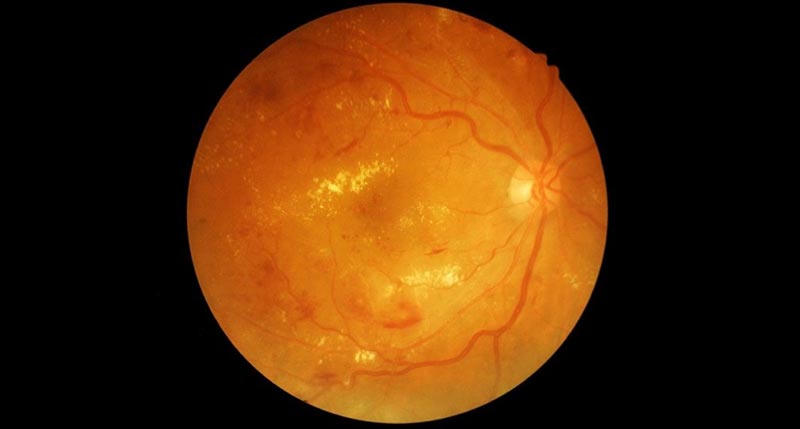The US Centers for Disease Control estimate that there are 37.3 million Americans living with diabetes. That’s about 10% of our nation’s population! What’s worse: About one in five of those people are not aware that they have this dangerous chronic health condition.
In addition, 96 million more Americans (more than one in three of us) have a condition called prediabetes and have elevated blood sugar levels.
In total, that’s 133.3 million people at risk for diabetic eye disease that can cause blindness. People with diabetes are at high risk for eye diseases and conditions, including diabetic retinopathy, diabetic macular edema, retinal detachment, glaucoma, and cataracts.
Why is this alarming? Because people with diabetes have very high, often uncontrolled sugar levels in their blood. This ongoing level of high blood sugar damages blood vessels in the entire body, putting them at increased risk for heart disease, kidney disease, and potential blindness.
High blood sugar levels damage the tiny, sensitive blood vessels that supply oxygenated blood to the eyes, retinas, and other structures that enable your vision. When those tiny vessels suffer significant damage, the result is a loss of vision.
Diabetic Retinopathy Explained
One of the most common diabetic eye diseases is diabetic retinopathy. It occurs when high blood sugar damages the tiny, sensitive blood vessels that supply the retina. A healthy retina is critical to good vision. The retina is a highly sensitive layer of cells located in the back of your eye.
When blood vessels that supply the eye become damaged, they leak. This limits the blood flow to the sensitive cells in the retina and can cause blurred or wavy vision. That is the essence of diabetic retinopathy. If left untreated, that blurred vision can progress to total blindness.
You are at risk for developing this diabetic eye disease if you have any type of diabetes. These include Type 1, Type 2, and even Gestational Diabetes during pregnancy. Unfortunately, the longer you have been living with diabetes, the more likely it is that you will develop retinopathy.
Other risk factors include smoking, high blood pressure, high cholesterol, and, of course, uncontrolled blood sugar levels. It’s critical for diabetic patients to keep blood sugar levels in the target range through careful monitoring and lifestyle changes. These efforts can literally save your sight.
Diabetic Retinopathy Progression
When first diagnosed, you may experience wavy or blurry vision. You may see spots or flashes of light and feel like your vision is distorted. Performing detailed, up-close work such as reading or sewing may become difficult due to the impact on your vision. Diabetic retinopathy typically affects both eyes at the same time.
Diabetic retinopathy has two distinct stages:
In the early or “non-proliferative” stage, the retina’s blood vessels start to weaken and bulge. They leak blood into the most detail-oriented cells of the retina, called the macula. The macula enables your central vision needed to see faces, read, and watch tv. Blood pooling near the macula causes it to swell, a condition called macular edema — the most typical cause of blindness for people with diabetic retinopathy.
Advanced diabetic retinopathy is called the proliferative stage. When the existing blood vessels in your eye have been damaged and aren’t functioning well, the body tries to grow new blood vessels to supply the eye. However, these new blood vessels don’t form well. Their fragile walls bleed into the center of the eye, causing dark spots in mild cases or total vision blockage in severe cases. You might have trouble seeing colors, empty or dark areas in your visual field, or even total vision loss.
Treating Diabetic Retinopathy
Early detection is key. By having a dilated, comprehensive eye exam with your optometrist every year, you can catch the early stages of diabetic retinopathy when the disease is more treatable.
Fortunately, there are ongoing clinical trials testing new medicines and treatments to address diabetic retinopathy.
Currently, the treatments for diabetic retinopathy include:
- Laser therapy. A laser is used to help seal the blood vessels and create some scar tissue that will slow the growth of new blood vessels in the eye
- VEGF inhibitor medications slow the progression of new blood vessel proliferation.
- Vitrectomy, a procedure to remove part or all of the vitreous, the clear gel-like tissue that fills the eye.
Prevent or Delay the Impact of Diabetic Retinopathy
Diabetic retinopathy can be a devastating diagnosis. But patients have the power to impact the outcome of this disease through:
- Annual Eye Exams. Your first line of defense is to see your eye doctor once a year or more often if he or she recommends it. Regular appointments enable your optometrist to closely monitor your vision and disease progression and recommend treatment.
- Control blood sugar. Your vision may depend on your ability to keep blood sugar levels in your target range.
- Control blood pressure and cholesterol levels, which lowers your risk for advanced disease.
- Quit smoking! Not just for your eyes but for your overall health
- Get moving. Exercise promotes good circulation and can help you manage your diabetes and protect your vision.
When you focus on these best practices for keeping diabetic retinopathy at bay and follow the guidance from your eye doctor about treatment for the condition, you have the best possible chance to protect your vision.


